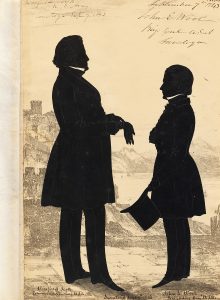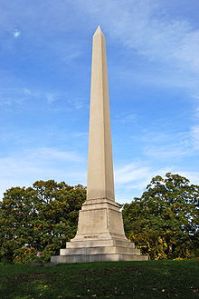Book Review: Courage Above All Things: General John Ellis Wool and the U.S. Military, 1812—1863
 Courage Above All Things: General John Ellis Wool and the U.S. Military, 1812—1863
Courage Above All Things: General John Ellis Wool and the U.S. Military, 1812—1863
By Harwood P. Hinton Hinton and Jerry Thompson
University of Oklahoma Press, 2020, $45.00 hardcover
Reviewed by David T. Dixon
Like many historical figures who were prominent in their time and all but forgotten today, John Ellis Wool may be best known as the oldest general in the Civil War (he was 77 in 1861). If that had been his only distinction, noted scholar Harwood Hinton would not have spent more than fifty years compiling this monumental biography, which was completed by Jerry Thompson of Texas A&M International University four years after Hinton’s death.
Wool’s resume was as extensive as any member of the U.S. Army’s nineteenth century professional officer corps. He earned promotions for his service at Queenstown and Plattsburgh in the War of 1812, was second in command to General Zachary Taylor at the Battle of Buena Vista in 1847, and commanded the Union Army’s department of Virginia during the capture of Norfolk in 1861. When not at war, Wool found himself in key administrative roles that spanned the continent. He assisted General Winfield Scott in the Cherokee Removal in 1836—7, enforced neutrality on the northern borders of New York and New England during the Canadian rebellion in 1838, contested filibusterers and managed land disputes between white settlers and Native on the West Coast in the 1850s, and commanded the Department of the East while headquartered in New York City during the draft riots of 1863.
Wool was a controversial figure in most of his assignments. His talents and foibles are described in equal measure, thanks to Thompson’s extensive editing and rewrites of Hinton’s manuscript that was originally submitted to the press in 1962.
The book’s title suggests that Wool was an accomplished warrior. A few key engagements reveal his sound understanding of logistics, strategy, and tactics augmented by an aggressive nature and coolness under fire; but his key talents were administrative. He toured Europe in an effort to modernize U.S. Army artillery and he was frequently called on to reorganize various departments in an army that was constantly growing and shrinking as military necessity dictated. His energy and zeal in helping the army purchase arms, munitions and supplies, commandeer ships, and direct troop placements at the onset of the Civil War were remarkable for a person at any age, let alone someone pushing 80.

Wool stood considerably less than five and a half feet tall. He lost both parents in childhood, and possessed only a country school education. But he was bright and enterprising. During his tireless efforts to promote himself to his superiors, he was often described as a petty, petulant, and inconsistent martinet. Wool was recalled in a dispute over private property rights in Alabama during the Cherokee Removal, but later exonerated by a court of inquiry. Arrested by the French Consul for interfering with filibustering expeditions in Mexico, he was subsequently relieved of command in the Department of the Pacific for his failure to protect white settlers in Oregon and Washington from Native American tribes. Wool was censured for his role in the Confederate capture of Harper’s Ferry in 1862 and criticized for directing lucrative military contracts to his brother-in-law. His hesitation in responding to the New York draft riots forced his retirement from active duty in August 1863.
Wool was a fearless and loyal soldier of extraordinary drive and intellect who dedicated his entire adult life to the service of his country. But he lacked the talent of an inspirational leader and collaborator. In the war with Mexico he was nicknamed “Old Fussy.” Some described him as “old womanish” and one of the U.S. military’s “epauletted grannies.” Wool even described himself as “a housekeeper” at one point in his long career. Hinton and Thompson question Wool’s capacity for intimacy based on hundreds of letters to his wife that evinced little if any loving emotion. Post-war letters written by Wool to Andrew Johnson, Ulysses S. Grant, and Edwin Stanton pleading for help in defending himself against lawsuits brought by aggrieved Baltimore Unionists generated no replies.
Wool’s efforts to salvage his reputation dimmed with his opposition to the Radical Republicans whom he accused on having “n—-r on the brain.” He was stung by Winfield Scott’s autobiography, wherein Scott diminished Wool’s role at Queenstown in 1812. After all, the good solider had allowed Zachary Taylor to claim the glory at Buena Vista when it was Wool who had chosen the defensive position and developed the successful battle strategy.
Wool failed to convince historians of his day to write his biography. Efforts to erect a statue of him in his hometown of Troy, New York in 1867 fizzled; but Wool himself made sure he would be remembered as a military hero. At his death in 1869, Wool willed $50,000 (nearly $1 million in today’s dollars) for the construction of his funerary monument in Troy’s Oakwood Cemetery. The gigantic obelisk, fashioned from a single piece of granite, towers more than 75 feet, the second tallest such marker in New York state.

Hinton and Thompson’s definitive biography of this complex man is not a gripping page-turner packed with drama and suspense. For serious students wishing to understand the inside machinations of the antebellum U.S. Army, however, it is a useful resource. Wool saved nearly every relevant scrap of paper, retained each important letter, and kept thousands of military records in a fifty cubic foot compendium that is now housed at the New York State Library in Albany. The University of Oklahoma Press enhanced Wool’s biography with beautiful interior design, including elegant maps by Carol Zuber-Mallison. An extensive bibliography and 74 pages of end notes augment this worthy contribution to military history.

John Bull’s historic house is owned by Russell Sage College in downtown Troy, NY. The house is used for administrative purposes but has some limited original furnishings.
Thanks Rosemary
Thank you for this good review. The book only contains a limited discussion on Wool’s involvement with the campaign to take Norfolk in 1862. For a fuller treatment, especially on Wool’s interactions with Abraham Lincoln who had an interesting involvement in the campaign, readers should consult Steve Norder’s excellent recent Lincoln Takes Command book. Of course, the Norder book was not available to the authors of the Wool biography you just reviewed.
Great catch, John. In reviewing the bibliography in more detail, I find that the overwhelming number of secondary sources date from the twentieth century. Professor Thompson certainly had his hands full in attempting to finish, edit, and rewrite significant parts of Hinton’s manuscript. Hinton had vision problems the last 16 years of his life that limited his reading and writing productivity. Under those circumstances, it would have been terribly difficult and possibly even disingenuous to add more recent scholarship than Hinton himself had consulted. In the end, it was Hinton’s life work that Thompson’s efforts secured and recast into a published work.